New chart: Calcium phosphate products compared
December 6, 2007 -- Editor's Note: A few years ago there were no calcium phosphate products to be had and now they seem to be everywhere and in every form. It's confusing, and our October report sorting out these products was one of the most popular articles on our site. But we weren't satisfied. To do justice to the variety on the market, Assistant Editor Rabia Mughal spent the past few weeks compiling data from the universe of calcium phosphate product vendors. The resulting chart is below. It shows what form the product comes in, where you can get it, and how the manufacturer says it works.
Our chart does not offer price comparisons, for a simple reason: it would be misleading to compare the cost of a package of gum to the cost of a tube of prophy paste, to the cost of a toothpaste, a varnish, a gel, or a rinse. That doesn't mean price isn't an issue. For example, Arm & Hammer's Mentadent replenishing white toothpaste with amorphous calcium phosphate (ACP) will run you $3.79 for a 3.5 ounce tube, while four ounces of Oravive and Restore toothpastes with NovaMin go for $7.95 and $7.49 respectively. ProClude, Ortek's prophy paste with SensiStat is $49.95 for a four ounce tube ( good for sixty applications), and GC America's MI Paste with CPP-ACP (Recaldent) costs $133.50 for a 10 tube pack (each tube is 40 grams.)
But as you'll recall from our article -- republished below -- caries experts are just beginning to get familiar with three different formulas of calcium phosphate and the many products that contain them. And it will probably never be possible to know how many cavities you can prevent per dollar spent on any of them. So for now, your best bet may be to choose one and become familiar with it, before focusing on the cost.
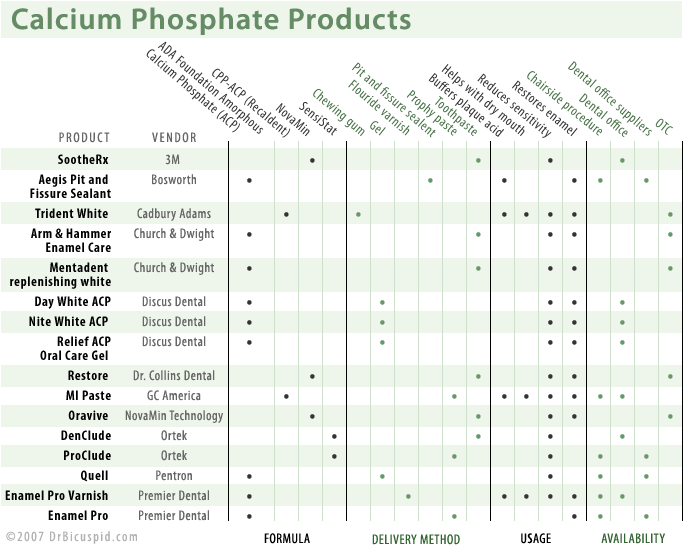 |
When a window breaks, you replace it with another pane of glass. To fill a pothole, you pour in more asphalt. So what if you could do the same thing to a carious lesion? That's the notion behind calcium phosphate treatments: fixing holes in enamel by pasting in the stuff that's missing. Researchers have been tinkering with this approach for years. Now, some say, it's time for general dentists to start slathering the mineral on their patients' teeth.
In recent years, the trickle of clinical studies on calcium phosphate concoctions has grown into a stream, with a score of products coming to market. In an August 20, 2007 news release, the American Dental Association (ADA) -- whose own research foundation invented a way of applying calcium phosphate -- called it "The Next Big Thing."
"I don't think most dentists are aware of it," said John Hicks, DDS, MD, PhD, a professor of pathology at Baylor College of Medicine and of pediatric dentistry at the University of Texas, Houston. "But it probably does work."
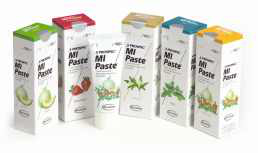 |
| MI Paste by GC America |
Why only "probably?" Because even those researchers like Hicks who have experimented with calcium phosphate in the lab haven't put it through the ultimate tests needed to convince the U.S. Food and Drug Administration: randomized, clinical trials conducted within U.S. borders.
But researchers have done virtually everything short of that: soaked extracted teeth in calcium phosphate solutions, painted the compound onto animal teeth, mixed it into gum chewed by people wearing removable slabs of enamel. Again and again the experiments have shown that the right formulation can indeed restore the minerals lost to bacterial action. The process seems to accelerate the natural remineralization that takes place constantly in the human mouth: calcium and phosphate in human saliva crystallize into hydroxyapatite -- the material of which enamel is made.
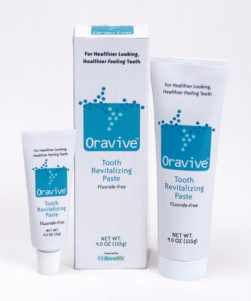 |
| Oravive by NovaMin Technology |
At the June 2006 meeting of the International Association of Dental Research, researchers from Australia reported good results from a big clinical trial on their own calcium phosphate system. They randomly assigned 2,720 adolescents to either chew a sugar-free gum containing calcium phosphate three times per day, or an identical gum without the compound. The investigators took x-rays at the beginning of the study and again two years later. The result: Fifty-six percent more carious lesions had remineralized in the teeth of the calcium phosphate group than in the teeth of the placebo group.
In some experiments, calcium phosphate appears to be just as powerful as fluoride in combating caries. Better yet, the two seem to go together like brick and mortar. "Adding calcium phosphate increases the efficacy of the fluoride," says Ming Tung, PhD, a chemist who invented the formula promoted in the American Dental Association news release. Mixing his formulation of calcium and phosphate into fluoride varnish effectively puts twice as much fluoride on the tooth, he says. And the fluoride, once incorporated into the enamel, makes it stronger that calcium phosphate could alone.
If calcium phosphate is such hot stuff, why has it taken so long to find its way into dental products? It's not as simple as dabbing minerals straight onto teeth, Dr. Tung explains, because in solid form they won't bind to the teeth. Instead, he has worked with a compound called amorphous calcium phosphate (ACP) which, when combined with water, crystallizes onto the teeth in the form of new enamel.
Which product should you use?
The American Dental Association Foundation has licensed Dr. Tung's formula to several companies including Church & Dwight, makers of Arm & Hammer Mentadent Replenishing White toothpaste. Inside the tube are separate chambers, keeping the calcium and phosphate separate until you squeeze out a dollop of paste. In the mouth, the two combine to form ACP which crystallizes onto teeth.
The product looks promising, says Dr. Hicks. But he noted that Dr. Tung has rivals. The Australian team, led by Eric C. Reynolds, AO, head of the school of dental science at the University of Melbourne, Australia, took a different approach to ACP. They noticed that milk products seemed to have beneficial effects on tooth enamel and realized that casein phosphopeptides (CPP) could stabilize the molecules until they are applied to teeth, and help bind them to plaque, bacteria, soft tissue, and dentin where they are slowly released to form enamel. The Australians have licensed their formula for CPP-ACP to GC America, which sells it as MI Paste in the United States and Canada and Tooth Mousse elsewhere.
The list of new calcium approaches doesn't stop there. At least two other formulas are also competing for the market. NovaMin uses bioactive glass (silicate) to release calcium and phosphate ions into the saliva, where they can crystallize onto teeth. SensiStat uses arginine in conjunction with calcium alone.
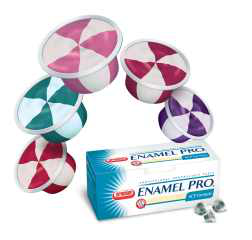 |
| Enamel Pro by Premier Dental |
And the new products comes in multiple forms. There are toothpastes and prophy pastes, chewing gums, gels, varnishes and rinses. Which one should your patients use?
"MI Paste has the most research behind it," says Dr. Hicks, who hasn't received any money from the companies making calcium phosphate products. Only the Australian team has conducted large clinical trials. (They're the ones who tried calcium phosphate gum in the study with 2,720 teenagers. The team assumes that CPP-ACP will work as well in a prophy paste as it did in chewing gum form.) MI Paste, however, can't be used by people with milk allergies. And it is only available through dental supply companies, which means they have to go to a dentist to get it.
"Mentadent would be good choice as an over the counter treatment," Dr. Hicks says. "It's less expensive to use and has a good delivery system." Mentadent Replenishing White (not to be confused with other Mentadent toothpastes) has started to appear on some drug store shelves. Since the FDA won't approve claims about remineralization, Church & Dwight says that the product "restores enamel luster." That's a cosmetic claim, so it doesn't have to be proved.
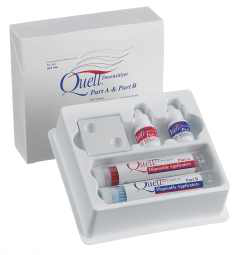 |
| Quell by Pentron |
Other products using Dr. Tung's formula have won the FDA nod to be marketed as desensitizing agents. ACP blocks dentin tubules in exposed tooth roots, so patients are no longer jolted by heat, cold, and intense sweets, he says. The makers of MI Paste, NovaMin and SensiStat claim to desensitize teeth the same way.
Some products containing calcium phosphate do claim they remineralize enamel; the FDA allows that because these products also contain fluoride.
When should you use it?
"I expect the best results in people with low salivary levels," says Kevin Donly, DDS, chair of pediatric dentistry at the University of Texas, San Antonio, who specializes in caries. "If you don't have enough salivary flow, you don't have enough calcium phosphate." He defines "low" salivary flow as less than 0.5 milliliters per minute, about half the normal rate.
Dr. Hicks recommends using calcium phosphate on any patients with white spots. (A common problem with orthodontic patients, who develop the spots under their braces.) "If patients have white spot lesions and you see changes, use either Mentadent [toothpaste] or MI Paste," he says. Some dentists give their patients MI Paste to use at home while others apply it in the office.
Both Dr. Hicks and Dr. Donly would like to see more research done, but they aren't holding their breath; a big clinical trial would require a huge number of patients, especially in the United States where the rate of caries is fairly low. Faced with waiting indefinitely for solid information and going ahead on the basis of preliminary results, both experts recommended jumping in. "Is it doing any good?" said Dr. Donly. "I don't know. I think so."
No comments:
Post a Comment